• 肌肉肌腱韧带组织构建 tissue construction of the muscle, tendon and ligament • 上一篇 下一篇
女性短距离速滑运动员下肢关节等速肌力特征
黄达武1,刘 露2,朱 星1,王新宝1,陈月亮3
- (江西师范大学,1体育学院,2心理学院,江西省南昌市 330022;3湖北理工学院体育部,湖北省黄石市 435003)
Characteristics of isokinetic muscle strength of lower limb joints in elite female short track speed skaters
Huang Dawu1, Liu Lu2, Zhu Xing1, Wang Xinbao1, Chen Yueliang3
- (1Sports College, 2School of Psychology, Jiangxi Normal University, Nanchang 330022, Jiangxi Province, China; 3Department of Physical Education, Hubei Polytechnic University, Huangshi 435003, Hubei Province, China)
摘要:
文章快速阅读:
.jpg) 文题释义:
肌力:是指肢体作随意运动时肌肉收缩的力量。检查方法是嘱患者上下肢依次作各关节伸、屈运动,并克服检查者所给的阻力,观察肌力是否正常、减退或瘫痪,并注意瘫痪部位。一般上肢作上臂的外展、内收、前臂伸屈、腕的伸屈、手指的外展、内收、握拳;下肢作屈髋、小腿伸屈,足跖及背屈等。在病情需要时,尚需对有关的每个肌肉进行分别检查。
等速肌力训练:是指利用等速仪器,根据运动过程中肌力大小的变化,由机器提供相匹配的阻力,使整个关节按照预先设定的速度进行运动的一种训练方法,又称可调节抗阻训练或恒定速度训练。等速训练也分为向心性训练和离心性训练两种不同的肌肉训练方法。
文题释义:
肌力:是指肢体作随意运动时肌肉收缩的力量。检查方法是嘱患者上下肢依次作各关节伸、屈运动,并克服检查者所给的阻力,观察肌力是否正常、减退或瘫痪,并注意瘫痪部位。一般上肢作上臂的外展、内收、前臂伸屈、腕的伸屈、手指的外展、内收、握拳;下肢作屈髋、小腿伸屈,足跖及背屈等。在病情需要时,尚需对有关的每个肌肉进行分别检查。
等速肌力训练:是指利用等速仪器,根据运动过程中肌力大小的变化,由机器提供相匹配的阻力,使整个关节按照预先设定的速度进行运动的一种训练方法,又称可调节抗阻训练或恒定速度训练。等速训练也分为向心性训练和离心性训练两种不同的肌肉训练方法。
.jpg) 文题释义:
肌力:是指肢体作随意运动时肌肉收缩的力量。检查方法是嘱患者上下肢依次作各关节伸、屈运动,并克服检查者所给的阻力,观察肌力是否正常、减退或瘫痪,并注意瘫痪部位。一般上肢作上臂的外展、内收、前臂伸屈、腕的伸屈、手指的外展、内收、握拳;下肢作屈髋、小腿伸屈,足跖及背屈等。在病情需要时,尚需对有关的每个肌肉进行分别检查。
等速肌力训练:是指利用等速仪器,根据运动过程中肌力大小的变化,由机器提供相匹配的阻力,使整个关节按照预先设定的速度进行运动的一种训练方法,又称可调节抗阻训练或恒定速度训练。等速训练也分为向心性训练和离心性训练两种不同的肌肉训练方法。
文题释义:
肌力:是指肢体作随意运动时肌肉收缩的力量。检查方法是嘱患者上下肢依次作各关节伸、屈运动,并克服检查者所给的阻力,观察肌力是否正常、减退或瘫痪,并注意瘫痪部位。一般上肢作上臂的外展、内收、前臂伸屈、腕的伸屈、手指的外展、内收、握拳;下肢作屈髋、小腿伸屈,足跖及背屈等。在病情需要时,尚需对有关的每个肌肉进行分别检查。
等速肌力训练:是指利用等速仪器,根据运动过程中肌力大小的变化,由机器提供相匹配的阻力,使整个关节按照预先设定的速度进行运动的一种训练方法,又称可调节抗阻训练或恒定速度训练。等速训练也分为向心性训练和离心性训练两种不同的肌肉训练方法。摘要
背景:研究显示,速滑运动员国际级健将组表现出较国家健将组更合理的关节肌力特征;另一项研究还显示,力量指标与成绩高度相关,说明速滑运动员的下肢关节肌力特征与专项竞技能力密切相关。
目的:研究优秀女子短距离速滑运动员下肢关节等速肌力特征,为运动员改进训练提供参考并为进一步揭示项目特征提供数据支撑。
方法:运用德国产Isomed 2000等速测试系统对中国4名优秀女子短距离速滑运动员(分别编号为1,2,3,4,均为国际健将)下肢髋、膝、踝3个关节进行向心等速测试。正式测试前,运动员在各测试角速度下进行3次亚极限强度的适应性练习,间隔2 min后开始正式测试。在参考预试验结果的基础上将测试角速度定为低速60 (°)/s和高速180 (°)/s。低速重复5次,高速重复7次,屈伸循环进行,不同速度间隔5 min,各速度屈伸阶段均取最高值进行研究。
结果与结论:①高、低速测试间,踝关节及膝关节各数据有良好对应关系,但髋关节没有;②踝、膝关节峰力矩随速度增长下降,平均功率随速度增长而增长;③速度对踝、膝关节肌力比有影响,但对髋关节没有;速度对峰力矩角影响较小;④运动员2屈、伸肌表现均较好;运动员1左、右腿平衡性有待提高;运动员3踝关节肌力发展较好,但膝、髋关节伸肌群速度力量有待提高;运动员4膝关节肌力发展较好,但踝、髋关节伸肌群速度力量有待提高;⑤中国优秀运动员膝、踝关节屈伸肌得到全面发展,但髋关节较差;优秀运动员峰力矩更大,肌力比有专项特征,左、右腿膝关节峰力矩平衡性较好,峰力矩角稳定,且符合专项特征,优秀速滑运动员膝关节肌力具有共性特征,但应重视其髋部肌群肌力的全面发展。
中国组织工程研究杂志出版内容重点:组织构建;骨细胞;软骨细胞;细胞培养;成纤维细胞;血管内皮细胞;骨质疏松;组织工程
ORCID: 0000-0003-1767-7619(黄达武)
中图分类号:
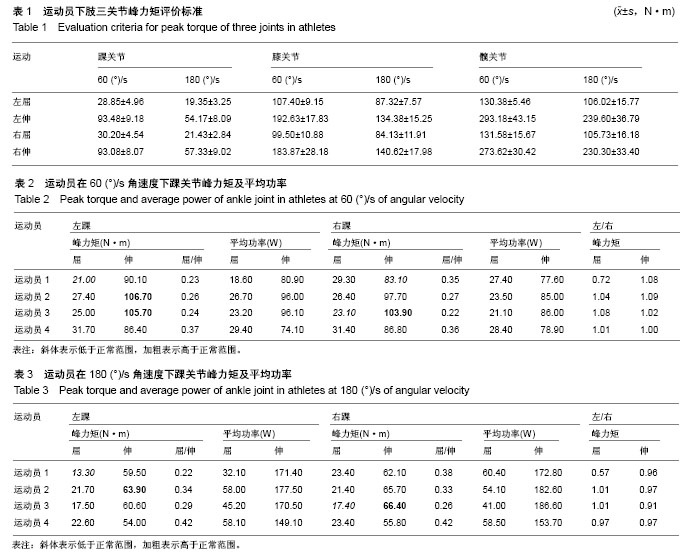
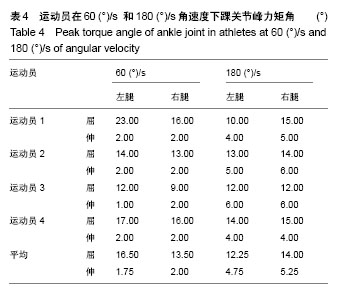
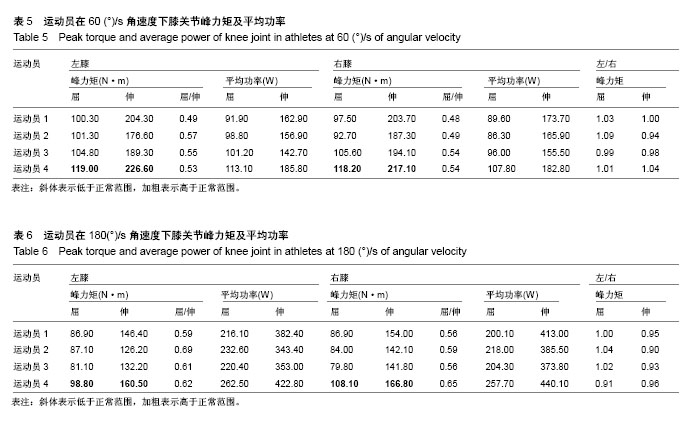
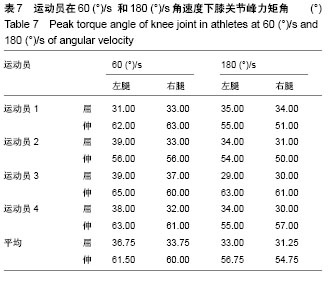
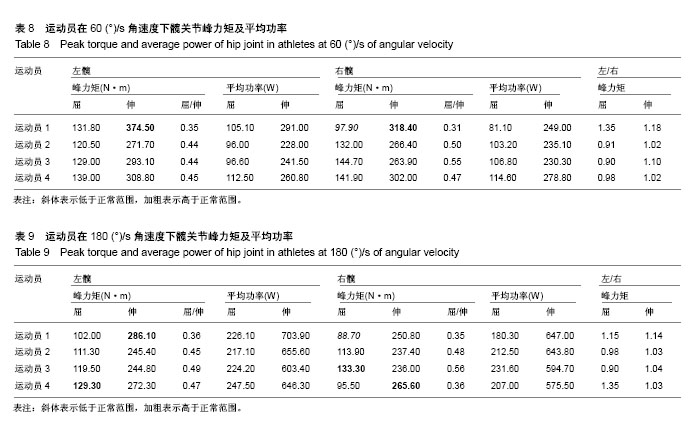
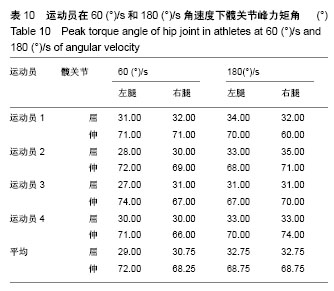
.jpg) 文题释义:
肌力:是指肢体作随意运动时肌肉收缩的力量。检查方法是嘱患者上下肢依次作各关节伸、屈运动,并克服检查者所给的阻力,观察肌力是否正常、减退或瘫痪,并注意瘫痪部位。一般上肢作上臂的外展、内收、前臂伸屈、腕的伸屈、手指的外展、内收、握拳;下肢作屈髋、小腿伸屈,足跖及背屈等。在病情需要时,尚需对有关的每个肌肉进行分别检查。
等速肌力训练:是指利用等速仪器,根据运动过程中肌力大小的变化,由机器提供相匹配的阻力,使整个关节按照预先设定的速度进行运动的一种训练方法,又称可调节抗阻训练或恒定速度训练。等速训练也分为向心性训练和离心性训练两种不同的肌肉训练方法。
文题释义:
肌力:是指肢体作随意运动时肌肉收缩的力量。检查方法是嘱患者上下肢依次作各关节伸、屈运动,并克服检查者所给的阻力,观察肌力是否正常、减退或瘫痪,并注意瘫痪部位。一般上肢作上臂的外展、内收、前臂伸屈、腕的伸屈、手指的外展、内收、握拳;下肢作屈髋、小腿伸屈,足跖及背屈等。在病情需要时,尚需对有关的每个肌肉进行分别检查。
等速肌力训练:是指利用等速仪器,根据运动过程中肌力大小的变化,由机器提供相匹配的阻力,使整个关节按照预先设定的速度进行运动的一种训练方法,又称可调节抗阻训练或恒定速度训练。等速训练也分为向心性训练和离心性训练两种不同的肌肉训练方法。